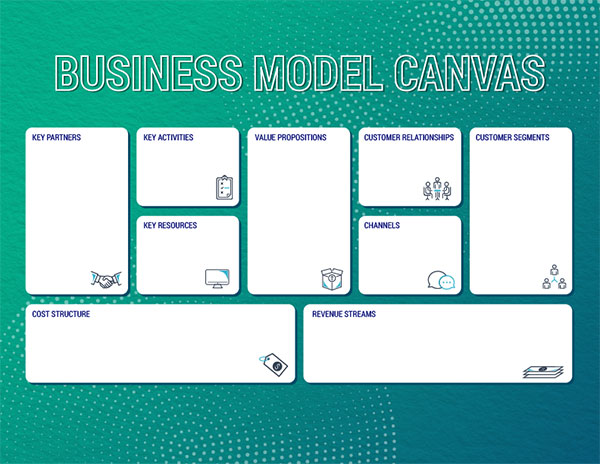Lesson 3: Business Model Canvas
What You’ll Learn: When it comes to transitioning an idea into a business, the Business Model Canvas is one of the fastest and best ways to think through your business before you spend a dime. It offers a time-saving shortcut to the traditional business plan process and will quickly give you insights into the viability of your new idea.
Business Model Canvas (continued)
Canvas Structure
The Business Model Canvas was created by Alex Osterwalder and Yves Pigneur in their book with the catchy title – Business Model Generation. Yes, it’s still in print, and yes, it’s on Amazon in printed and Kindle formats.
The Business Model Canvas covers these main areas. These are covered in greater depth as separate topics in this lesson.
- Customer Segments
- Distribution Channels
- Customer Relationships
- Revenue Streams
- Key Resources
- Key Partners
- Key activities
- Cost Structure
- Customer Value Proposition
The Canvas Map

Digital Print Version
Many of these elements, of course, are found in a traditional business plan as well. But the canvas provides a quick overview without all the support materials that are required by a lender. Business plans are great when you’re meeting with a banker, but who is going to lend any money to a first-time entrepreneur who’s in startup mode anyway?
In stark contrast to a traditional business plan which requires an MBA to understand it, the Business Canvas Model can be understood quickly by just about anyone.
As your business grows, the canvas can grow with you. Because it’s easy to update, you can use it as a guidepost as your business expands and matures. You can also use it as a brainstorming tool to test new ideas or changes to the existing model.
Some of this body of work you’ve already tackled in your Ideation Stage lesson. The research and data you collected there can be summarized and placed in the relevant section of the canvas.
Next, we’ll look at the various pieces of the Business Canvas so you can see how they fit together and support one another.
